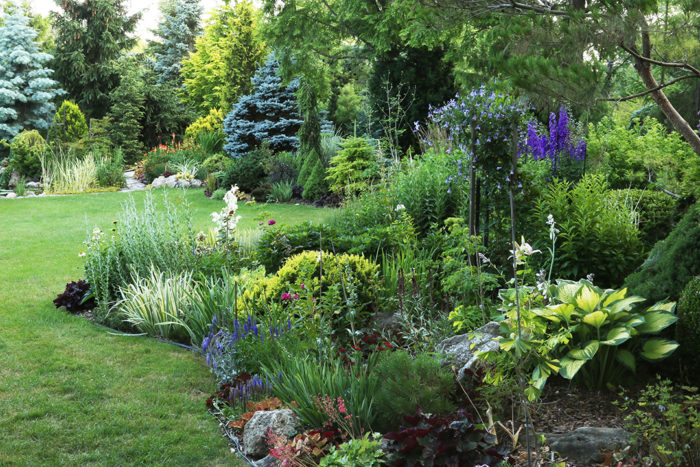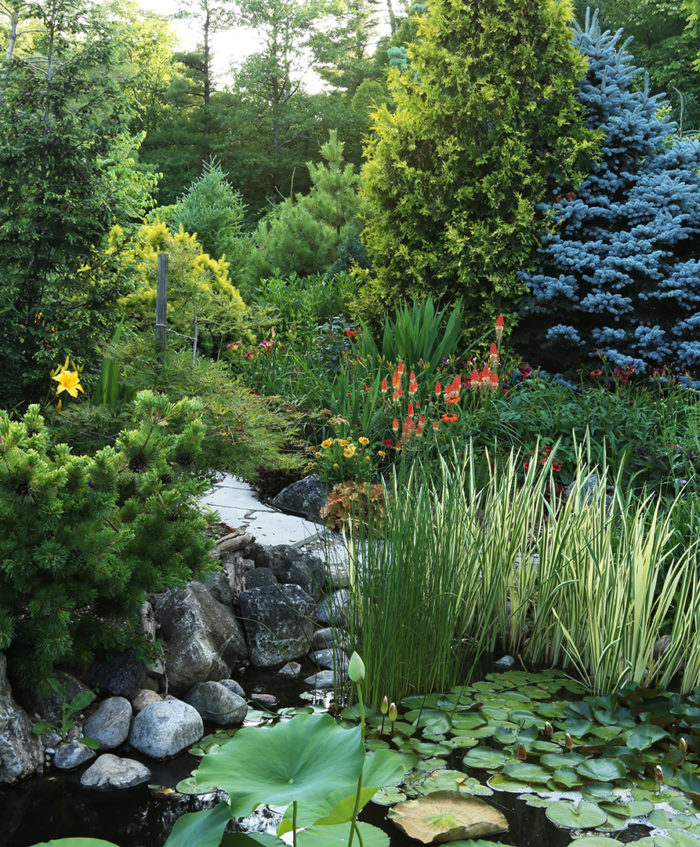
Chen Choo is a retired nuclear engineer with an artist’s eye and a passion for collecting plants. He and his wife, Linda, have created a garden in southern Ontario filled with a fascinating mix of cold-hardy perennials, trees, shrubs, and vines, combined to showcase prized specimens and to give each plant the space and conditions it needs to strut its stuff. The Choos’ garden is never really finished, since assorted new plants keep following them home. We visited in midsummer, when the beds were bursting with lush color and texture, to ask Chen about the thought process behind his compelling plant combinations and great garden rooms.
Q: A walk through your garden is such an adventure—there’s something new to see around every corner. Can you explain your approach to breaking the space into smaller garden rooms?
A: I think of the garden as consisting of a number of “sanctuaries,” small, informal garden rooms with invisible and overlapping boundaries. Most include a sitting spot, and the boundary of a sanctuary is often defined by the viewing perspective from this seating area. The view from one room often overlaps with that of adjacent sanctuaries. Within these smaller spaces, I can experiment with planting compositions and also control growing conditions to meet the needs of specific plants.
For plant addicts like my wife and me, open space needs to be optimized to make room for more planting space. The main deck on the back of our house, the pergola by the pool, and the gazebo by the water garden provide space for relaxing and for viewing the garden. Other sanctuaries were developed gradually over the years as we built new paths and beds. Every open space needs a purpose, even if it’s only as a connecting element between beds. Otherwise it will be just unnecessary maintenance overhead.
Q: Your garden has a huge and diverse collection of plants, but it feels so well organized. What’s your strategy for giving the garden this feeling of cohesiveness and balance?
A: All gardeners develop their own sense of how an ideal garden looks. I approach garden-making as a composition—like a painting or a poem—but one that will never end. My whimsical doodling is far from perfect, but it’s much more fun than trying to adhere to strict principles and a time line for completion.
To accommodate a diverse plant palette while maintaining a semblance of harmony, I only aim to keep an overall feeling of natural flow. My designs include some interruptions, subtle “imperfections” such as curved paths and surfacing rocks. Unexpected foliage textures, forms, and color changes evoke a sense of intrigue. Ideally, I would like plants to appear naturally located, in spots where their individual beauty can be appreciated as I come across them on a garden stroll. Conifers anchor the flow and balance the looseness of perennials. The horizontal curvature of paths and beds is a natural flow element and implies a sense of continuity. My endless design process typically involves studying garden photos in winter, recording a list of desired changes, then editing the beds in spring.
Q: How do you approach working with color?
A: A successful play of colors adds another level of enjoyment to an area, but I must admit that my attempts to articulate specific color schemes are still experimental. I have given certain beds nicknames, like the ”Burning River,” which contains hot-colored plants, the “Icy River,” which has a lot of cool color, and the “Almost-White Garden,” which contains white and colors that make white look better. The nicknames remind me of my intent when I’m adding new plants or shuffling plants around.
A refined color composition is hard to achieve given the transient nature of flowering times, bloom succession, and color changes that occur because of weather conditions. Any corrections or adjustments need to be spread over multiple growing years. However, the results of most of my color experiments have been rewarding. The need to constantly accommodate an assortment of new plants makes maintaining reasonable color harmony a challenge; fortunately, I am not obsessed with solid color massing or repeats as long as a color patch is somewhat analogous. In fact, playing with subtle color spreads and the controlled strategic use of contrasting colors often results in a more lasting look.
Q: We love the rockery and the wall-mounted trellis behind it. How did you come up with that design?
A: I dread the weeding involved in maintaining a rock garden, but I wanted to dabble with some rockery plants that I find charming. Creating a few rockery areas within larger beds solved this problem, and they are small enough that weeding does not feel futile. These may not look like typical rock gardens, but they give me enough space to enjoy some rockery plants.
When I started to collect clematis, the sunny, south-facing wall of our home seemed ideal for a simple trellis structure. I sketched a whimsical design to fit the location—a no-frills layout in which all the elements are functional. The vertical lines are for climbing, and the horizontal lines are for trellis supports. The various heights of vertical members create a gentle curve that softens the rigidness of the framework, while horizontal lines hint at a classical border pattern.
Q: What is your strategy for placing hardscaping elements?
A: Casual paths permeate our garden. They allow us to visit all our plants, and they facilitate the management and placement of plant collections. They also help to unify all the beds. Most of our paths are just wide enough for a stroll. Some beds have short, narrow, wood-chip-covered trails cutting through them for easier plant visiting and maintenance. Paths make a green shady area more interesting, evoking a sense of space like a woodland trail. Coming across a fern by a trail is more refreshing than seeing it enclosed in a formal bed.
Q: Can you explain your process for laying flagstone walks?
A: Our early flagstone paths followed a textbook approach, with a thick limestone screening layer and mechanical compaction under closely set stones. Recently I have simplified my approach. I grade without digging into the stable soil layer too much, then lay down a layer of professional-grade landscape cloth or 6-mil poly with random holes punched. Next comes a couple of inches of gravel or 3/8-inch pea stone. The depth of this drainage layer can be adjusted to accommodate flagstones of various thicknesses. I backfill with more gravel after all the flagstones are laid.
With this simplified approach, I expected to touch up the leveling of paths each spring, but they have remained reasonably stable for a number of years. I suspect the loosely fitted flagstones and fast-draining gravels minimize heaving and are probably somewhat self-leveling. I would not recommend my simplified approach for other gardeners at all!
Q: How does your water feature relate to the garden rooms that surround it?
A: The gazebo adjacent to the water garden is our favorite sanctuary. It’s a place to view plantings across the water and birds bathing in the shallow areas. I think of this water garden as an abstraction that evokes a small corner of a tropical mountain stream in my birthplace, Borneo. Because my primary interest was the sight of open water and the gentle sound of a stream flowing, I have to resist adding too many aquatic plants. The gazebo was specifically designed to be an integral part of the water garden, putting the viewer close to the water surface and the stream. We raised the grade on the far side of the pond before we built the water garden; I did not want a waterfall to appear out of an artificial heap of stones. From the gazebo, glimpses of other sanctuaries or paths invite viewers to explore the facing beds.
Q: What is your strategy for placing trees?
A: Over time, a lot of transplanting has been necessary! While I like the look of trees hugging each other, as they do in a natural woodland, estimated growth rates are unreliable, particularly for our climate. So sometimes a tree will outgrow its space or show disappointing attributes, and it will need to be removed. When possible, I try to plant less-hardy trees with minimal southern exposure to sun and wind, avoiding wet-feet conditions in winter.

Fine Gardening Recommended Products

isYoung Birdlook® Smart Bird Feeder with Camera
Fine Gardening receives a commission for items purchased through links on this site, including Amazon Associates and other affiliate advertising programs.

Corona® Multi-Purpose Metal Mini Garden Shovel
Fine Gardening receives a commission for items purchased through links on this site, including Amazon Associates and other affiliate advertising programs.

ARS Telescoping Long Reach Pruner
Fine Gardening receives a commission for items purchased through links on this site, including Amazon Associates and other affiliate advertising programs.



















Comments
Wow! How beautiful!
Log in or create an account to post a comment.
Sign up Log in